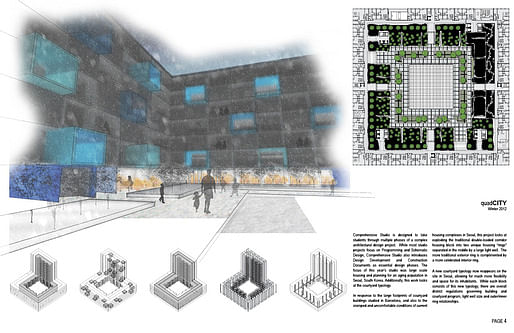
Building off of my Thesis work (which i will do a blog post on soon) I recently completed a fellowship proposal that would allow me to expand on some of the core issues. Here is a look at what I submitted.

“…one would have to get past the idea of urban fabric altogether and look at ways buildings are spatially charged, how objects hold space around them, and how the space around buildings stage the object quality of the building.”
- Jason Young, Density of Emptiness
Research Abstract
As Jason Young describes in the above quote, the urban fabric of the city is only one lens with which to view the city. Another lens would be to look at the spaces created, and destroyed, by the city. In a world where the city is the great cultivator of space, buildings are its primary tool. Buildings are deployed within the city to domesticate the vastness of the open landscape into an agglomeration of spatial experiences. These experiences are calibrated by the density with which buildings are deployed. They induce a wide range of physical and emotional reactions when occupied by the inhabitants of the city.

Through this lens, the success of the city is measured by the ability of its inhabitants to share in these reactions and in doing so form strong connections between each other, the city and the buildings that made these spaces possible. When a city’s tools are taken away however, when buildings begin to disappear, either by demolition or vandalism, these connections are broken. Without buildings to hold the space around them, spatial experience is lost.

My current work has focused on this fleeting condition, which for example, can be seen in the city of Detroit through the scarcity of spaces between houses, a space which once held the entire life of the city between its adjacent foundations. It is a space which created neighbors, established trusts and connected entire populations. Unfortunately, Detroit’s once vast tracks of housing have dematerialized into isolated pockets of single houses left to occupy entire residential blocks, and in doing so lost these spaces and severed connections between the city’s residents.
 Detroit is just one of many cities which have endured a dematerialization of space as economic downturn hits major cities across the globe. While in Detroit this loss of space is made evident within its residential neighborhoods, other cities have experienced the same loss in different ways. This is because while economic downfall is shared by many cities, the evolution of those cities is always unique. Buildings are deployed throughout the city in response to current conditions and demands. However, when buildings built to meet divergent demands and a multitude of changing conditions find themselves adjacent to each other; they form unpredictable associations and unique spatial conditions. The resulting physical and emotional reactions by the city’s inhabitants are also unique, and native only to that city. I believe that understanding these spatial conditions is critical to an understanding of the relationships between architecture, space and its inhabitants.
Detroit is just one of many cities which have endured a dematerialization of space as economic downturn hits major cities across the globe. While in Detroit this loss of space is made evident within its residential neighborhoods, other cities have experienced the same loss in different ways. This is because while economic downfall is shared by many cities, the evolution of those cities is always unique. Buildings are deployed throughout the city in response to current conditions and demands. However, when buildings built to meet divergent demands and a multitude of changing conditions find themselves adjacent to each other; they form unpredictable associations and unique spatial conditions. The resulting physical and emotional reactions by the city’s inhabitants are also unique, and native only to that city. I believe that understanding these spatial conditions is critical to an understanding of the relationships between architecture, space and its inhabitants.

With the support of the Foundation, I would like to expand on my research into the dematerialization of space in an effort to explore spaces within a declining post-industrial landscape. Just as in Detroit, the vernacular architecture of other cities which have fallen into economic decline can reveal other spatial experiences on the verge of disappearing through the loss of buildings that spatially charge them.
My work will highlight these endangered spaces and draw out their latent potential through a series of representational efforts. Just as in my previous work in Detroit the work will not focus directly on the architecture of the city, but the spatial qualities of its density. The success of the project will be determined by its ability to not only bring attention to these spaces, but to derive new architectural forms through an understanding of how density creates spatial conditions and how a city’s inhabitants interact with those conditions.
Additional Portfolio Pages







I am a graduate student and an entrepreneur at the University of Michigan Taubman College where my studies are focused on leveraging design ideas across multiple scales and platforms. Meeting at the intersection between design, tectonics and fabrication, I am continually exploring how a design idea can navigate complex material and production systems and evolve into fully realized architectural artifacts.
No Comments
Block this user
Are you sure you want to block this user and hide all related comments throughout the site?
Archinect
This is your first comment on Archinect. Your comment will be visible once approved.